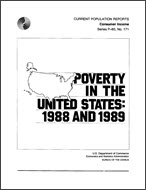Poverty in the United States: 1988 and 1989
Poverty in the United States: 1988 and 1989
Introduction
This report presents social and economic characteristics of the population below the poverty level in 1988 and 1989 based, respectively, on the March 1989 and 1990 Current Population Surveys (CPS). The poverty definition used here is that adopted for official Government use by the Office of Management and Budget and consists of a set of money income thresholds that vary by family size and composition. Poverty status is based on responses to income questions which in the March CPS refer to pre-tax income received in the previous calendar year. Families or individuals with income below their appropriate poverty threshold are classified as below the poverty level. These poverty statistics exclude inmates of institutions, Armed Forces members in barracks, and unrelated individuals under 15 years of age. Poverty thresholds are updated every year to reflect changes in the Consumer Price Index. For example, the average poverty threshold for a family of four was $12,092 in 1988 but $12,675 in 1989. Average poverty thresholds in 1989 varied from $6,311 for a person living alone to $25,480 for a family of nine or more members. The poverty definition used here is based on pre-tax money income only, excluding capital gains, and does not include the value of noncash benefits such as employer-provided health insurance, food stamps, or Medicaid. For further discussion, see the section entitled "Collection and Limitations of Poverty Data."
The data in the report consist of cross classifications of poverty status by such characteristics as age, race, Hispanic origin, family relationship, educational attainment, work experience and type of income received. Although the primary focus of the tables is on the United States as a whole, some tables also present data by region and type of residence. The text of this report was drawn from the advance report, Series P-60, No. 168, Money Income and Poverty Status in the United States: 1989. Due to a minor error in the assignment of the appropriate poverty threshold to some unrelated individuals, minor differences exist between the numbers shown here and in those published in the above-mentioned report. None of these differences changed the statistical significance of comparisons made in the advance report with the exception of the poverty rate for persons 65 years and over. The poverty rate for the elderly declined from 12.0 to 11.4 percent between 1988 and 1989.1
The detailed tables in this report represent a new table package designed to meet the changing data needs of policymakers and the general public within the limitations of the CPS data. Tables were added to address frequently asked questions and, similarly, some tables in which there was little current interest were dropped from our standard table package. Our old table package is not available for the years after 1987. Our new package is available for 1987, but will not be published for that year.
In the text, the terms "poverty population", "poor", and "below the poverty level" are used interchangeably, as are the terms "nonpoor" and "above the poverty level". Characteristics such as age and marital status are as of the survey date (i.e. either March 1989 or March 1990), while income, poverty status, and work experience data refer to the whole previous calendar year ( i.e. 1988 or 1989). In the report text, the year cited refers to the "income" year.
__________
1 Specifically, the error involved the incorrect assignment of the poverty threshold based on the age of another person in the household to several unrelated individuals on the March 1990 CPS file. Correcting this problem changed the number of poor from 31,534,000 to 31,528,000 and the number of poor unrelated individuals changed from 6,766,000 to 6,760,000. The number of families below the poverty level did not change and neither the poverty rate for persons or for unrelated individuals changed.
A Note on Language
Census statistics date back to 1790 and reflect the growth and change of the United States. Past census reports contain some terms that today’s readers may consider obsolete and inappropriate. As part of our goal to be open and transparent with the public, we are improving access to all Census Bureau original publications and statistics, which serve as a guide to the nation's history.
Others in Series
Publication
Publication
Publication






